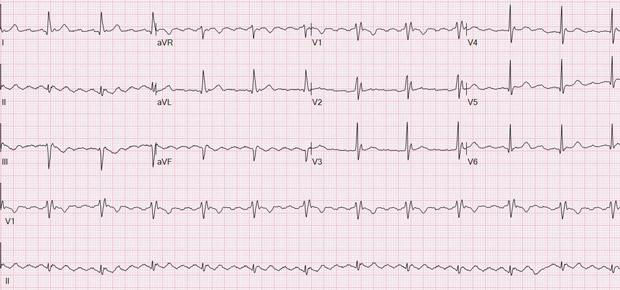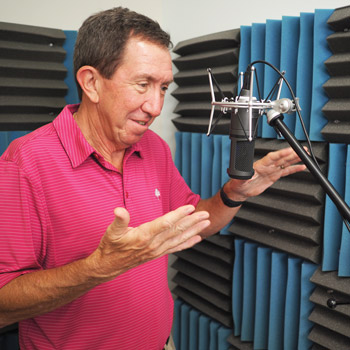MKSAP Quiz: Evaluation for palpitations, fatigue
A 78-year-old man is evaluated for palpitations, worsening fatigue, and exercise intolerance. Two months ago, he was diagnosed with atrial flutter and subsequently underwent cardioversion to normal sinus rhythm. Ambulatory electrocardiographic monitoring following cardioversion demonstrated recurrent atrial flutter with an average ventricular rate of 69/min. Medical history is significant for hypertension and coronary artery disease. Medications are warfarin, metoprolol, lisinopril, low-dose aspirin, and atorvastatin.

On physical examination, pulse rate is 73/min and irregular. Other vital signs and findings on physical examination are normal.
Laboratory studies are significant for normal serum thyroid-stimulating hormone and serum N-terminal pro–B-type natriuretic peptide levels.
An electrocardiogram is shown. A stress echocardiogram demonstrates normal wall motion at rest and during stress. The left ventricular ejection fraction is greater than 55%.
Which of the following is the most appropriate treatment?
A. Amiodarone
B. Cardiac catheterization
C. Cardioversion
D. Catheter ablation
Critique
The most appropriate treatment is D. Catheter ablation. This question can be found in MKSAP 18 in the Cardiovascular Medicine section, item 12.
Catheter ablation is the most appropriate treatment for this patient with electrocardiographic evidence of atrial flutter. Atrial flutter is an organized macro-reentrant tachycardia with discrete regular atrial activity on electrocardiogram, usually with a rate of 250/min to 300/min. Typical atrial flutter is characterized electrocardiographically by a sawtooth pattern with inverted flutter waves in leads II, III, and aVF and positive flutter waves in lead V1. Management of atrial flutter is similar to that for atrial fibrillation and includes catheter ablation, antiarrhythmic drug therapy, and cardioversion. Catheter ablation is the definitive treatment for typical atrial flutter, owing to a very high success rate (>95%) and low complication rate. This patient with typical atrial flutter has symptoms (palpitations, fatigue, and exercise intolerance) despite adequate rate control with metoprolol, and treatment with catheter ablation offers the best balance of benefits and risks.
Antiarrhythmic drug therapy carries a high risk for recurrent atrial flutter and is therefore not the best option for this patient. Additionally, amiodarone is associated with substantial risk for end-organ toxicity, including thyroid dysfunction, neurologic side effects (such as tremor), liver dysfunction, and pulmonary toxicity.
Cardiac catheterization would be appropriate if there were a high pretest probability of obstructive coronary artery disease; however, this patient has normal findings on echocardiogram without evidence of stress-induced wall motion abnormalities.
Cardioversion to restore sinus rhythm could be considered, but this patient is hemodynamically stable and already has experienced a recurrence of atrial flutter after previous cardioversion. Cardioversion may therefore be ineffective for long-term control of the patient's symptoms.
Key Point
- Patients with symptomatic atrial flutter despite adequate medical therapy and rate control should undergo catheter ablation.




